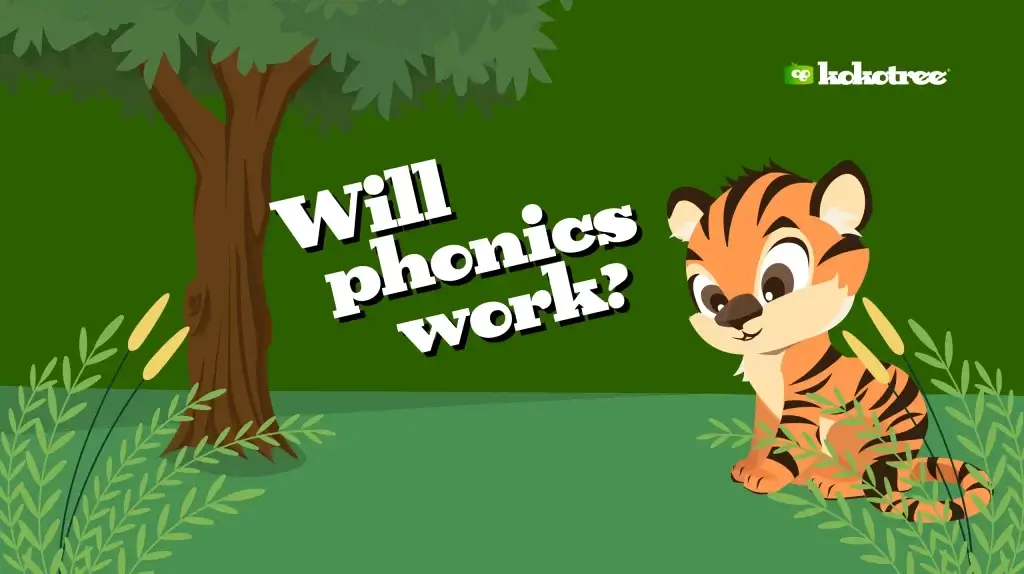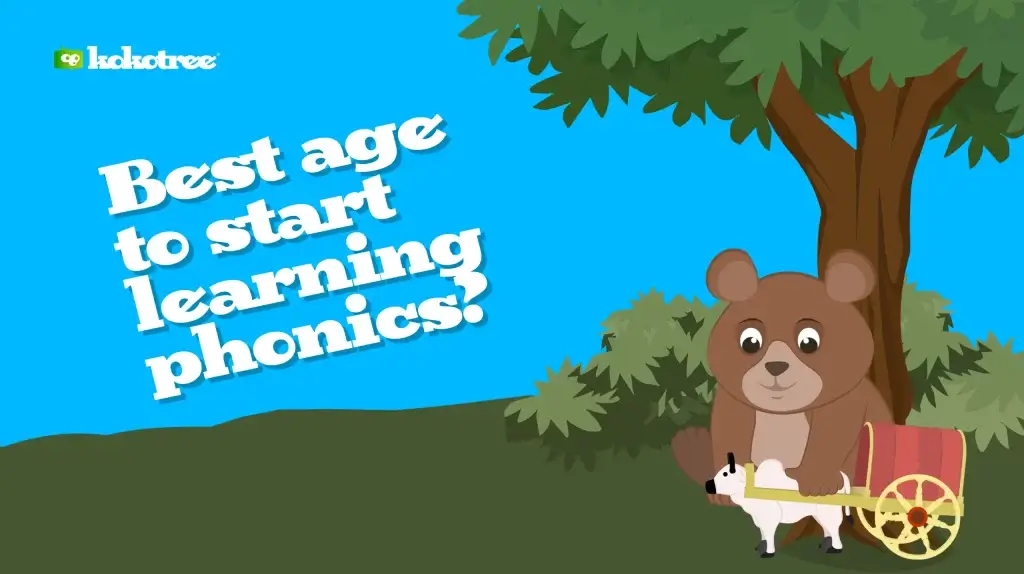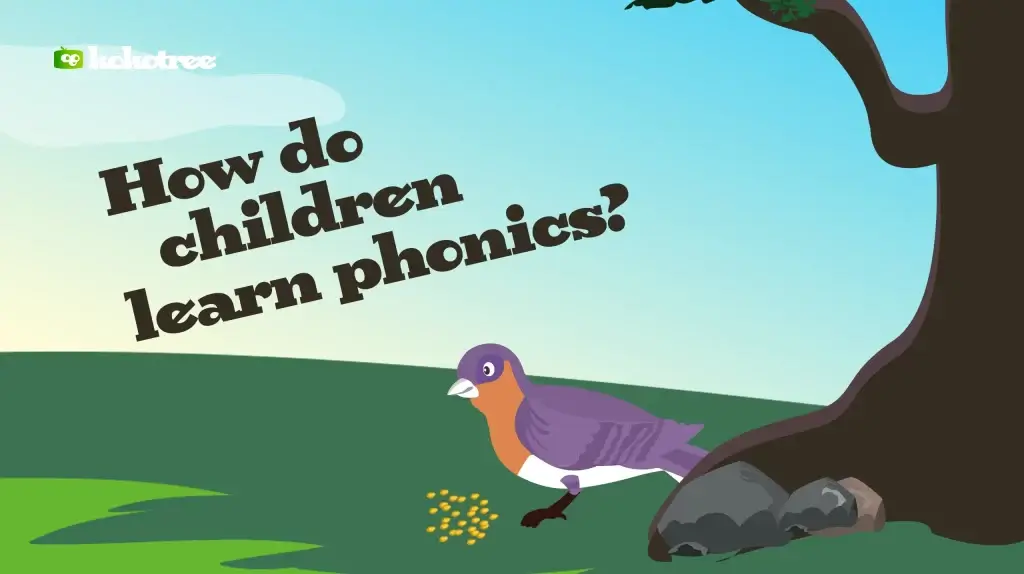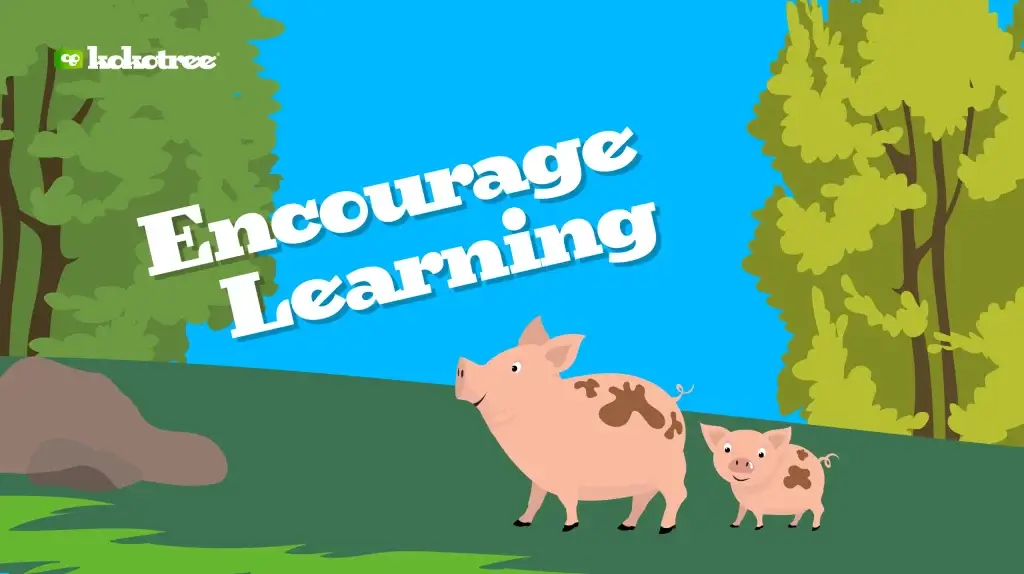

Many people think it is important to teach phonics step by step, while others disagree. We at Kokotree feel that phonics is an excellent technique to teach children to read. Phonics teaches children the relationship between letters and sounds, which helps them decode words.

Phonics is a way of teaching children to read by helping them match letters with the sounds they make. There are 44 phonemes in the English language and 26 letters in the alphabet.
Here’s how phonics work:
When you teach phonics, you help children understand the relationships between letters and sounds because it helps them “decode” new words they see and hear. It also helps them spell words correctly when they write them down.
There are many different ways to spell each sound. For example, the word “bat” can be spelled three ways – bat, bate, and batt. Children who learn phonics know that bat is pronounced /bæt/ because they can see that B matches the sound /b/.
Phonemic awareness is the recognition of unique sounds in spoken words, enhancing reading as it bridges sounds to letters. It’s nurtured at home and fortified in school with sound-focused activities. This can involve sharing stories with repetitive patterns, imitating nature sounds, or games that prompt students to identify rhymes or words with similar initial sounds. As they progress in letter knowledge, further questions can be:
Learn more about Phonemic Awareness
There are many different ways to teach phonics. Some programs use games and activities to help children learn the relationships between letters and sounds. Other programs focus on teaching children to read words by sight. Still, other programs use a mix of both approaches.
The most important thing is to find a program that your child will enjoy and that you feel comfortable using. There are many great phonics programs; we suggest one effective way of teaching here.
The first step in teaching phonics is introducing the sounds the letters make. You can show your child pictures of objects that start with the same sound. For example, you can show a cat picture and say, “This is a cat. It says /k/ /a/ /t/.”
Once your child is familiar with the sounds the letters make, you can teach them how to “blend” those sounds together to make words. Oral blending is when you sound out a word for your child and have them say it to you. For example, you can say, “/c/ /a/ /t/. What’s that?” Your child will reply, “Cat!”
Once your child is comfortable with oral blending, you can teach them to “segment” words into their sounds. Segmenting is when you say a word and then have your child break it down into its sounds. For example, you can say, “What sound does /c/ make?” and your child will reply, “/k/.”
Once your child knows the letters’ sounds, you can start teaching them how to match those sounds with the letters. A helpful way to do this is to use games and activities. There are many great games and activities that you can use to teach letter-sound relationships.
One simple exercise is to make a “sound chart” with your child. You will need a piece of paper and some crayons or markers to make a sound chart. Write each letter of the alphabet on a separate line. Then, help your child think of a word that starts with each sound. For example, you might write “cat” next to the letter C. Once you have a word for each letter, have your child draw a picture of the words next to the appropriate letter. This will help them understand how the sounds and letters match up.
Once your child knows the sounds the letters make, and how to match them with the letters, they can start reading words! Start with short words that contain only the sounds your child has learned. You can move on to longer and more complex words as they become more confident readers.
One way to help your child read words is to use “sound boxes.” You will need a piece of paper and a pencil to make a sound box. Draw a line under each letter in the word you want your child to read on the paper. For example, if you wanted them to read the word “cat,” you would write:
CAT
Then, please have your child say each sound in the word and draw a picture next to it. For example, they might draw a cat picture next to the letter C. This will help them “sound out” the word and read it independently.
We devote a lot of time and effort to our curriculum of educational videos delivered through our educational app for kids to cover phonics thoroughly.
Reading isn’t just a skill—it’s an adventure. So why shouldn’t learning phonics be equally exciting? Here are some creative methods to inject fun into phonics:
Introducing phonics is a student’s maiden voyage into independent reading. Your teaching approach can set a lively and engaging tone. Here’s hoping these ideas stir your creativity. Now, let’s kindle that zest in our students!
Teaching phonics step by step is essential for several reasons:
In summary, teaching phonics step by step is a research-backed, effective approach to ensuring students gain a solid understanding of language, which aids in reading, writing, and overall communication skills.
Teaching phonics to kids involves making the process interactive and enjoyable. Use visual aids, toys, games, and songs to make learning engaging. Start with simple letter-sound relationships and gradually progress to word formation and reading. Regular practice and reinforcement are crucial to help kids remember and apply the phonics skills they’ve learned.
The best way to teach phonics is through a systematic and sequential approach. Begin with individual letter sounds, then progress to blends, digraphs, and diphthongs. Incorporate multi-sensory methods to cater to various learning styles. This might involve using flashcards for visual learners, songs and chants for auditory learners, and writing or tracing letters for kinesthetic learners.
When teaching phonics to preschoolers, start with the basics. This includes learning the alphabet and the sound each letter makes. Use simple words that have a direct phonetic correlation to help children understand the concept. Also, use games, songs, and fun activities to keep preschoolers engaged and excited about learning.
The easy way to teach phonics involves breaking down the process into manageable steps. Start with individual letter sounds, then introduce two-letter combinations, and gradually progress to words. Use fun activities and games to practice these skills, and consistently reinforce what they’ve learned. Phonics apps and interactive online resources can also make the process easier and more engaging for children.
The exact age to introduce phonics to toddlers can vary based on their developmental readiness. However, introducing phonics early, around preschool age (2-5 years), can lay a solid foundation for future reading skills. Start with simple sound-letter relationships, using playful activities and visual aids to make it engaging and appropriate for their age.
Teaching children phonics sounds is a crucial part of their language development. This involves recognizing letters and understanding the sounds associated with each one. Use tools like phonics songs, flashcards, and interactive games to demonstrate these sounds. Remember, repetition and practice are key in helping children retain and apply this knowledge.
The goal of phonics instruction is to help children learn to read by assisting them in grasping the link between letters and sounds. The most successful phonics learning occurs in kindergarten or first grade. Systematic teaching must be planned carefully and delivered correctly if it is going to work with young pupils. It should cover letter forms, names, phonemic awareness, and all significant letter-sound links.
Explicit phonics instruction teaches children the relationship between letters and sounds and how to blend those sounds to make words. It is usually presented step-by-step so that children can easily follow along. This type of instruction often requires special materials, such as books, worksheets, and flashcards.
Implicit phonics instruction, on the other hand, exposes children to language without necessarily teaching them expressive skills. This can be done by reading aloud to them regularly, singing songs together, and engaging in conversations. While this instruction does not directly teach children about phonics, it provides them with valuable exposure to language, which can indirectly help them develop phonemic awareness and sound-symbol associations.
Both types of instruction are essential. Children must be able to discriminate between different sounds (auditory discrimination), and they need to be able to identify the correspondence between those sounds and letters (sound-symbol association). These skills form the basis for phonemic awareness, which is the ability to hear, identify, and manipulate individual sounds—phonemes—in spoken words.
Before you begin teaching your child preschool phonics, it is essential to make sure that they are developmentally ready for this type of instruction. Here are a few things to look for:
If your child is able to do all of these things, then they are likely ready to start learning phonics. If you are unsure, you can always consult with your child’s doctor or an educational specialist.

Yes! Phonics is an effective way to teach reading. It’s one of the most widely used methods for teaching reading worldwide. According to research, children who are taught using phonics:
There are many benefits of phonics, both for children and teachers. Some of the benefits of phonics include:
Phonics is essential because it helps children understand how the English language works. When children know how to match letters with sounds, they can start to read and spell words independently. This is an essential skill for school and life.
Children who learn phonics also easily learn to read in other languages. That’s because many languages use similar sound-letter relationships. So, once children understand how phonics works in English, they can also start to understand other languages.
Yes, many teachers still teach phonics in schools. While some teachers may use a different method, such as the whole language, most still incorporate phonics into their lessons. Research has shown that teaching phonics is an effective way to help kids learn to read.

Most experts agree that children should start learning phonics from preschool age three or four. This is because young children are just starting to learn how to use their sounds and letters. Starting at this age gives them a strong foundation on which to build their reading skills.
It’s difficult to give you a specific time frame since it varies depending on the kid and the program they’re using. Some kids may learn phonics in only a few weeks, while others might require several months. It’s crucial that youngsters are given ample opportunity to practice and master the skills they’re studying.
Nursery rhymes enhance children’s phonological sensitivity, which is the ability to hear, identify and manipulate sounds in words. Research has shown that phonological sensitivity is a crucial predictor of later reading success.
One way to nurture your child’s phonological sensitivity is by reading nursery rhymes together from an early age. Not only are nursery rhymes fun, but they also help children learn about the sound structure of language. This helps them become better readers and spellers when they start school.
When reading with your child, look for books with lots of repetition. Repeating words and phrases helps children learn new vocabulary, and it also helps them develop phonemic awareness.
Phonological awareness is the ability to hear, identify, and manipulate the sounds in spoken language. This ability is vital for learning to read. Children who are phonologically aware can often learn to read more quickly than those who are not.
Phonics is also crucial because it helps children read more fluently. When children know the relationships between letters and sounds, they can “sound out” words they don’t know, and this helps them read faster and with fewer mistakes.

Get free parenting tips, news, updates, and content from Kokotree.
There are many nursery rhymes that help teach phonics. Some of the most popular include:
These nursery rhymes help children learn about the sound structure of language, which is essential for reading success. All of these nursery rhymes are included in the Kokotree curriculum and are available through our service and app.

There are many different ways to teach phonics, and no one method is best for every child. Some of the most popular methods include synthetic phonics, analytic phonics, and embedded phonics.
There is no one “best” way to teach phonics. Some children may learn best with one method, while others may benefit from a different method. Ultimately, the best approach is the one that works best for your child.
If you’re not sure which method to use, talk to your child’s teacher or a reading specialist. They can help you determine which approach is best for your child.
When teaching phonics, it’s important to use a variety of materials and activities. This helps keep kids engaged and motivated, and it also helps them learn in different ways. Some great materials and activities to use include:
When teaching phonics, it’s important to make sure that kids are also getting plenty of practice reading real books. This helps them apply the skills they’re learning, and it also helps them develop a love of reading. Reading for pleasure is one of the best predictors of future reading success.
There is no set answer to this question. It depends on your child’s age, attention span, and level of interest. A good rule of thumb is to practice for a few minutes each day. You can break up the practice into shorter sessions if needed. Just be sure to keep it fun and engaging so that your child doesn’t get bored.

If your child seems uninterested in learning to read, there are a few things you can try to spark their interest. First, make sure they are familiar with the basic sounds of each letter in the alphabet. If they aren’t, review the individual letter sounds with them. Next, try incorporating games and activities into your lessons. Finally, be patient and keep practicing.
There are a variety of reasons why students may struggle with phonics. Some students have difficulty hearing the individual sounds in words, while others have trouble blending the sounds to form words. Additionally, some students may find the task of learning to read cumbersome and frustrating.
If your child is struggling with phonics, there are several things you can do to help them. First, make sure they are receiving regular instruction from a qualified teacher. If you’re teaching them at home, numerous resources are available online and in libraries to help you plan practical lessons. Additionally, there are many great games and apps specifically designed to help kids learn phonics fun and engaging. Finally, be patient and encourage your child to keep practicing.
There are a variety of fun and interactive and educational games that can help kids learn phonics. Many online games allow kids to practice identifying and pronouncing individual letter sounds. Some games also focus on blending sounds together to form words. And finally, some games teach kids how to read short stories and identify their different words.
Some great spelling games to help kids learn phonics include:
Alphabetical Order: In this game, kids must put alphabet letters in order from A-Z. This is an excellent way to review the individual letter sounds and learn how they go together.
Blending Words: In this game, kids must sound out and blend each word to spell it correctly. This is an excellent way for them to practice blending sounds together to form words.
Phonics Stories: In this game, kids must read short stories and identify the different words in them. This is an excellent way for them to practice reading independently and learn new vocabulary words.
These are just a few games that can help kids learn phonics. There are many other great games out there as well. The important thing is to find games that your child enjoys and that you feel comfortable using.
In addition to games, there are also a variety of books that can help kids learn phonics and help improve brain development. These books teach the individual letter sounds and how to blend them to form words.
Some great phonics books to help kids learn include:
These are just a few examples of books that can help kids learn phonics. There are many other great books out there as well. The important thing is to find books that your child enjoys and that you feel comfortable using.

In addition to games and books, a variety of apps can help kids learn phonics. These apps typically focus on teaching the individual letter sounds and how to blend them to form words.
Some great apps to help kids learn phonics include:
These are just a few examples of apps that can help kids learn phonics. There are many other great educational apps for toddlers out there as well. The important thing is to find apps that your child enjoys and that you feel comfortable using.
When teaching kids to read with phonics, you must find games, books, and apps that your child enjoys and feel comfortable using. Finding materials you and your child enjoy will make learning more fun and engaging for everyone involved.
While phonics is beneficial, there are some cons that we’d include in keeping this article balanced. There are a few potential cons of teaching kids phonics, such as:
Despite these potential drawbacks, teaching kids to read with phonics can be a very effective way to help them learn how to read. You will likely see great results if you are willing to devote the time and energy necessary. Additionally, there are many resources available to help you along the way.
Here we will review some of the frequently asked questions by parents when it comes to effectively introducing phonics into their children’s learning processes.
Phonics is a method of teaching children to read by helping them understand the relationship between letters and sounds. It is an essential tool for helping children learn to read and spell, as it allows them to decode words and understand the structure of the English language.
There are several steps you can take to teach phonics to your child. Some suggestions include the following:
There are many resources available to help you teach phonics to your child. Some options include:
The length of time it takes to teach phonics can vary depending on the child’s age, ability, and approach. Some children may be able to learn pronunciation in a few weeks, while others may take longer. Being patient and allowing your child to progress at their own pace is essential.
Yes, you can teach phonics to your child even if you are not a teacher. Many resources are available to help parents teach phonics to their children, including books, online resources, and apps. It is also helpful to seek guidance from your child’s teacher or a reading specialist if you have any questions or concerns.
There are many ways to make phonics learning fun for your child. Some ideas include:
If your child is struggling with phonics, it may be helpful to:
There are many ways to help your child practice phonics at home. Some ideas include:
Teaching kids to read with phonics can be a very effective way to help them learn how to read. You will likely see great results if you are willing to devote the time and energy necessary. Additionally, there are many resources available to help you along the way. Phonics is an essential reading skill that all kids should learn. You can help your child become a successful reader with a bit of time and effort.




